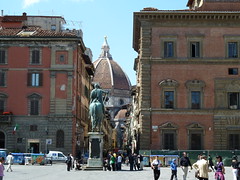 After getting settled at our hotel, we stepped back out into the piazza, eager to enjoy the remainder of a beautiful warm sunny day, and started to head for the center of town. From the equestrian statue in the piazza, the Via dei Servi runs just a few long blocks toward the cathedral, and even though the avenue was a nearly unbroken line of four or five story Renaissance buildings, the great red dome could be seen peeking above at the end of the avenue. That just begins to give you a sense of the scale of the cathedral. The huge dome was an architectural phenomenon when it was built in the early 1400s, and remains the largest masonry dome in the world today. When viewed from hills outside the city, the cathedral dome completely dominates the Florence skyline. Inside the city, one catches glimpses of the dome along avenues that run toward the central piazza. Coming to the end of the avenue, which runs into the side of the cathedral, we were fully impressed by its scale and its beauty, as our gaze turned upward to take in the tall walls (about 150 feet from the ground to the roof of the nave) and their geometric patterns of the red, green, and white marble that lined them. As we walked along the side of the nave toward the front, I was mindful that the cathedral architecture was achieving its aim, to keep us looking up (heavenward) in awe.
After getting settled at our hotel, we stepped back out into the piazza, eager to enjoy the remainder of a beautiful warm sunny day, and started to head for the center of town. From the equestrian statue in the piazza, the Via dei Servi runs just a few long blocks toward the cathedral, and even though the avenue was a nearly unbroken line of four or five story Renaissance buildings, the great red dome could be seen peeking above at the end of the avenue. That just begins to give you a sense of the scale of the cathedral. The huge dome was an architectural phenomenon when it was built in the early 1400s, and remains the largest masonry dome in the world today. When viewed from hills outside the city, the cathedral dome completely dominates the Florence skyline. Inside the city, one catches glimpses of the dome along avenues that run toward the central piazza. Coming to the end of the avenue, which runs into the side of the cathedral, we were fully impressed by its scale and its beauty, as our gaze turned upward to take in the tall walls (about 150 feet from the ground to the roof of the nave) and their geometric patterns of the red, green, and white marble that lined them. As we walked along the side of the nave toward the front, I was mindful that the cathedral architecture was achieving its aim, to keep us looking up (heavenward) in awe.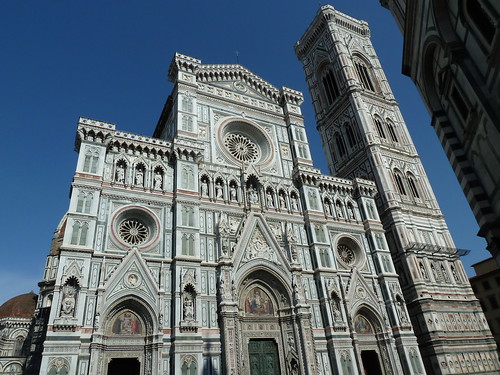 The feeling of awe and visual fascination only increased as we rounded the corner into the Piazza del Duomo, and turned back to view the façade. It is a dazzling display of neo-gothic architecture, taking the original tri-color geometric theme and kicking it up a notch into a wedding cake extravaganza of marble and statuary. The central part of the nave stands a full "head" above the "shoulders" of the aisles, and the façade keeps to that form. Unlike some cathedrals where the façade extends much higher than the actual structure behind it, this façade has substance behind it all the way up. It's hard to know where the begin to take it all in, but the design emphasizes the portals, a huge central one and two merely large ones on either side. Each has a deeply inset pointed arch (tympanum) filled with a mosaic, and above that a chevron-shaped pseudo-arch pointing up (heavenward, always), drawing your eye further up to the ornate rose window above. The whole pattern is echoed to scale in the secondary portals on either side. A gallery of niches with larger-than-life statues of the twelve apostles runs across the top of the "shoulders" and across the "neck". Four buttresses clamp onto the façade at the corners and the divisions, with double-lancet "windows" of green marble running all the way up. Above the rose windows is another gallery of quatrefoils filled with busts of great Florentines (mostly artists and architects, of course). No opportunity for a statue-filled niche or cornice is missed, decorated with borders of intricate inlay with the red, white, and green marble. Just when you think it can't get more baroque, you notice another level of detail of marble mosaic or busts of saints and popes worked into the pattern. Some people think that it's overwrought, but I think it suits a magnificent edifice of this grandeur. I mean, my God, it is one of the world's great cathedrals after all, it's entitled to be a bit overwrought.
The feeling of awe and visual fascination only increased as we rounded the corner into the Piazza del Duomo, and turned back to view the façade. It is a dazzling display of neo-gothic architecture, taking the original tri-color geometric theme and kicking it up a notch into a wedding cake extravaganza of marble and statuary. The central part of the nave stands a full "head" above the "shoulders" of the aisles, and the façade keeps to that form. Unlike some cathedrals where the façade extends much higher than the actual structure behind it, this façade has substance behind it all the way up. It's hard to know where the begin to take it all in, but the design emphasizes the portals, a huge central one and two merely large ones on either side. Each has a deeply inset pointed arch (tympanum) filled with a mosaic, and above that a chevron-shaped pseudo-arch pointing up (heavenward, always), drawing your eye further up to the ornate rose window above. The whole pattern is echoed to scale in the secondary portals on either side. A gallery of niches with larger-than-life statues of the twelve apostles runs across the top of the "shoulders" and across the "neck". Four buttresses clamp onto the façade at the corners and the divisions, with double-lancet "windows" of green marble running all the way up. Above the rose windows is another gallery of quatrefoils filled with busts of great Florentines (mostly artists and architects, of course). No opportunity for a statue-filled niche or cornice is missed, decorated with borders of intricate inlay with the red, white, and green marble. Just when you think it can't get more baroque, you notice another level of detail of marble mosaic or busts of saints and popes worked into the pattern. Some people think that it's overwrought, but I think it suits a magnificent edifice of this grandeur. I mean, my God, it is one of the world's great cathedrals after all, it's entitled to be a bit overwrought.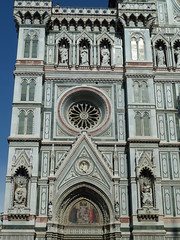 The façade is considered neo-gothic since, for various reasons, it wasn't added until the1870s, but it remains faithful to the gothic style of the cathedral, which was begun in 1296 and otherwise completed by 1469. To me, cathedrals in general and this one in particular are stunning human achievements, given that they are built over many generations and centuries, remaining (generally) faithful to an original vision. The men who began the cathedral knew they, their children, and their grandchildren would all be long dead before the cathedral was completed. The architects who began it did not know there would be sufficient resources and materials to finish it, and in the case of this cathedral, they didn't even possess the engineering know-how to erect what they envision, but merely had to go on faith that succeeding generations would somehow carry it out. The undertaking is as awesome a testament to faith as the structure itself.
The façade is considered neo-gothic since, for various reasons, it wasn't added until the1870s, but it remains faithful to the gothic style of the cathedral, which was begun in 1296 and otherwise completed by 1469. To me, cathedrals in general and this one in particular are stunning human achievements, given that they are built over many generations and centuries, remaining (generally) faithful to an original vision. The men who began the cathedral knew they, their children, and their grandchildren would all be long dead before the cathedral was completed. The architects who began it did not know there would be sufficient resources and materials to finish it, and in the case of this cathedral, they didn't even possess the engineering know-how to erect what they envision, but merely had to go on faith that succeeding generations would somehow carry it out. The undertaking is as awesome a testament to faith as the structure itself.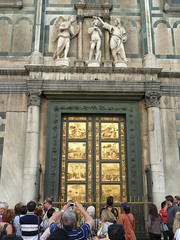 After taking in the façade for a while, we realized that we had our backs to the baptistry. This octagonal building is also done in white and green marble with geometric patterns, but its less ornate design and rounded rather than pointed arches indicate its Romanesque style. It's actually the oldest building of the cathedral complex, built between 1059 and 1128. Everyone from Dante to the Medicis, pretty much everyone who was anyone in Florence, was baptised here. But the big attraction of the baptistry are its gilded bronze doors, on the north, south, and east sides, which were the result of great artistic competitions in the Renaissance. In the early 1400s, Lorenzo Ghiberti won the honor of doing the north doors, which he labored on for 21 years. The doors were so beautiful that he was commissioned to do another set for the east doors, which took him 27 more years. These latter doors were even more beautiful than the first, and Michelangelo famously dubbed them the "Gates of Paradise", a name which has stuck to this day. The original doors have been taken indoors for restoration and preservation, but have been replaced with replicas so that the doors can be experienced on their original site. The doors are indeed marvelous. Of course being covered in burnished gold will make many things look marvelous, but beyond that, his artistry is exquisite. The bronze panels are deep relief, practically popping out in 3D. And Ghiberti fully exploits the Renaissance discovery of perspective to everything look realistic. (Before the Renaissance, art was generally flat and one-dimensional.) The doors comprise ten main panels, each featuring a major Old Testament biblical character. In most of the panels, all of the significant events in the life of the featured character are portrayed. For example, in one panel, Adam is created, Eve is created, they are tempted by the serpent, and they are booted out of Paradise, all in one fluid composition. Thus, not only are the panels 3D, they are 4D!
After taking in the façade for a while, we realized that we had our backs to the baptistry. This octagonal building is also done in white and green marble with geometric patterns, but its less ornate design and rounded rather than pointed arches indicate its Romanesque style. It's actually the oldest building of the cathedral complex, built between 1059 and 1128. Everyone from Dante to the Medicis, pretty much everyone who was anyone in Florence, was baptised here. But the big attraction of the baptistry are its gilded bronze doors, on the north, south, and east sides, which were the result of great artistic competitions in the Renaissance. In the early 1400s, Lorenzo Ghiberti won the honor of doing the north doors, which he labored on for 21 years. The doors were so beautiful that he was commissioned to do another set for the east doors, which took him 27 more years. These latter doors were even more beautiful than the first, and Michelangelo famously dubbed them the "Gates of Paradise", a name which has stuck to this day. The original doors have been taken indoors for restoration and preservation, but have been replaced with replicas so that the doors can be experienced on their original site. The doors are indeed marvelous. Of course being covered in burnished gold will make many things look marvelous, but beyond that, his artistry is exquisite. The bronze panels are deep relief, practically popping out in 3D. And Ghiberti fully exploits the Renaissance discovery of perspective to everything look realistic. (Before the Renaissance, art was generally flat and one-dimensional.) The doors comprise ten main panels, each featuring a major Old Testament biblical character. In most of the panels, all of the significant events in the life of the featured character are portrayed. For example, in one panel, Adam is created, Eve is created, they are tempted by the serpent, and they are booted out of Paradise, all in one fluid composition. Thus, not only are the panels 3D, they are 4D!(Check out highlights of our photos from Florence, or the complete set of first day pics on Flickr.)
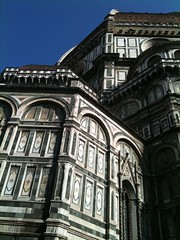

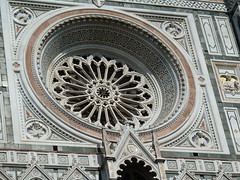

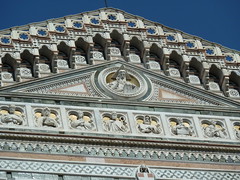







No comments:
Post a Comment